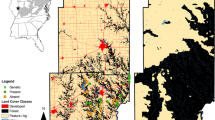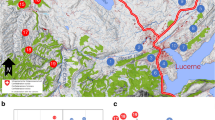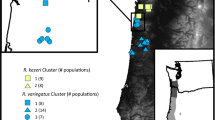Abstract
Urban expansion is creating environmental stressors through land use change, habitat fragmentation, and habitat loss. These stressors, along with a host of others, are driving precipitous declines in vertebrate taxa around the world. Amphibians, often requiring a narrow range of environmental conditions, can be especially susceptible to the stressors of environmental change. Despite habitat loss and degradation, some amphibian species continue to persist in altered urban landscapes. The red-backed salamander (Plethodon cinereus) is one such- species and in this study, we assess how habitat patch size affects population density and genetic diversity of salamander populations in and around an urban center in Ohio, United States. Further, we examined patterns of genetic differentiation and landscape connectivity to understand gene flow between populations and tested for historic demographic bottleneck effects. Populations were sampled from 9 urban forest patches ranging in size from less than 1 ha to approximately 250 ha. There was no apparent effect of contiguous habitat patch size on salamander density nor genetic diversity, but we did observe significant genetic differentiation between 97% of pairwise population comparisons. The differentiation observed was not a result of overland distance or effective distance due to landscape resistance. There was evidence of historic bottlenecks at every site. These results suggest that density is driven by within-patch heterogeneity and that genetic diversity is affected by drivers other than patch size or contemporary population density. Our study demonstrates that red-backed salamanders can persist in wooded, urban parks, but that genetic diversity remains susceptible to demographic changes.



Similar content being viewed by others

References
Adamack AT, Gruber B (2014) PopGenReport: simplifying basic population genetic analyses in R. Methods Ecol Evol 5(4):384–387. https://doi.org/10.1111/2041-210X.12158
Anantharaman R, Hall K, Shah V, Edelman A (2019) Circuitscape in Julia: high performance connectivity Modelling to support conservation decisions. ArXiv:1906.03542 [q-Bio]. Retrieved from http://arxiv.org/abs/1906.03542
Barbosa O, Tratalos JA, Armsworth PR, Davies RG, Fuller RA, Johnson P, Gaston KJ (2007) Who benefits from access to green space? A case study from Sheffield, UK. Landsc Urban Plan 83(2):187–195. https://doi.org/10.1016/j.landurbplan.2007.04.004
Best ML, Welsh HH Jr (2014) The trophic role of a forest salamander: Impacts on invertebrates, leaf litter retention, and the humification process. Ecosphere 5(2):1–19. https://doi.org/10.1890/ES13-00302.1
Bowne DR, Bowers MA (2004) Interpatch movements in spatially structured populations: a literature review. Landsc Ecol 19(1):1–20. https://doi.org/10.1023/B:LAND.0000018357.45262.b9
Burton TM, Likens GE (1975) Salamander populations and biomass in the Hubbard brook experimental Forest, New Hampshire. Copeia 1975(3):541–546. https://doi.org/10.2307/1443655
Cabe PR, Page RB, Hanlon TJ, Aldrich ME, Connors L, Marsh DM (2007) Fine-scale population differentiation and gene flow in a terrestrial salamander (Plethodon cinereus) living in continuous habitat. Heredity 98:53–60. https://doi.org/10.1038/sj.hdy.6800905
Chapuis M-P, Estoup A (2007) Microsatellite null alleles and estimation of population differentiation. Mol Biol Evol 24(3):621–631. https://doi.org/10.1093/molbev/msl191
Chen J, Saunders SC, Crow TR, Naiman RJ, Brosofske KD, Mroz GD et al (1999) Microclimate in Forest ecosystem and landscape EcologyVariations in local climate can be used to monitor and compare the effects of different management regimes. BioScience 49(4):288–297. https://doi.org/10.2307/1313612
Chiesura A (2004) The role of urban parks for the sustainable city. Landsc Urban Plan 68(1):129–138. https://doi.org/10.1016/j.landurbplan.2003.08.003
Collinge SK (1996) Ecological consequences of habitat fragmentation: implications for landscape architecture and planning. Landsc Urban Plan 36(1):59–77. https://doi.org/10.1016/S0169-2046(96)00341-6
Connors LM, Cabe PR (2003) Isolation of dinucleotide microsatellite loci from red-backed salamander (Plethodon cinereus). Mol Ecol Notes 3(1):131–133. https://doi.org/10.1046/j.1471-8286.2003.00373.x
Cosentino BJ, Brubaker KM (2018) Effects of land use legacies and habitat fragmentation on salamander abundance. Landsc Ecol 33(9):1573–1584. https://doi.org/10.1007/s10980-018-0686-0
Couvet D (2002) Deleterious effects of restricted gene flow in fragmented populations. Conserv Biol 16(2):369–376. https://doi.org/10.1046/j.1523-1739.2002.99518.x
Croci S, Butet A, Georges A, Aguejdad R, Clergeau P (2008) Small urban woodlands as biodiversity conservation hot-spot: a multi-taxon approach. Landsc Ecol 23(10):1171–1186. https://doi.org/10.1007/s10980-008-9257-0
Cushman SA (2006) Effects of habitat loss and fragmentation on amphibians: a review and prospectus. Biol Conserv 128(2):231–240. https://doi.org/10.1016/j.biocon.2005.09.031
Di Rienzo A, Peterson AC, Garza JC, Valdes AM, Slatkin M, Freimer NB (1994) Mutational processes of simple-sequence repeat loci in human populations. Proc Natl Acad Sci 91(8):3166–3170. https://doi.org/10.1073/pnas.91.8.3166
Ditchkoff SS, Saalfeld ST, Gibson CJ (2006) Animal behavior in urban ecosystems: modifications due to human-induced stress. Urban Ecosyst 9(1):5–12. https://doi.org/10.1007/s11252-006-3262-3
Du Y, Zou X, Xu Y, Guo X, Li S, Zhang X et al (2016) Microsatellite loci analysis reveals post-bottleneck recovery of genetic diversity in the Tibetan antelope. Sci Rep 6:35501. https://doi.org/10.1038/srep35501
Dudaniec RY, Wilmer JW, Hanson JO, Warren M, Bell S, Rhodes JR (2016) Dealing with uncertainty in landscape genetic resistance models: a case of three co-occurring marsupials. Mol Ecol 25(2):470–486. https://doi.org/10.1111/mec.13482
Falush D, Stephens M, Pritchard JK (2003) Inference of population structure using multilocus genotype data: linked loci and correlated allele frequencies. Genetics 164(4):1567–1587
Falush D, Stephens M, Pritchard JK (2007) Inference of population structure using multilocus genotype data: dominant markers and null alleles. Mol Ecol Notes 7(4):574–578. https://doi.org/10.1111/j.1471-8286.2007.01758.x
Fisher-Reid MC, Engstrom TN, Kuczynski CA, Stephens PR, Wiens JJ (2013) Parapatric divergence of sympatric morphs in a salamander: incipient speciation on Long Island? Mol Ecol 22(18):4681–4694. https://doi.org/10.1111/mec.12412
Frankham R, Lees K, Montgomery ME, England PR, Lowe EH, Briscoe DA (1999) Do population size bottlenecks reduce evolutionary potential? Anim Conserv 2(4):255–260. https://doi.org/10.1111/j.1469-1795.1999.tb00071.x
Garden JG, McAlpine CA, Possingham HP (2010) Multi-scaled habitat considerations for conserving urban biodiversity: native reptiles and small mammals in Brisbane, Australia. Landsc Ecol 25(7):1013–1028. https://doi.org/10.1007/s10980-010-9476-z
Gardner-Santana LC, Norris DE, Fornadel CM, Hinson ER, Klein SL, Glass GE (2009) Commensal ecology, urban landscapes, and their influence on the genetic characteristics of city-dwelling Norway rats (Rattus norvegicus). Mol Ecol 18(13):2766–2778. https://doi.org/10.1111/j.1365-294X.2009.04232.x
Gehlhausen SM, Schwartz MW, Augspurger CK (2000) Vegetation and microclimatic edge effects in two mixed-mesophytic forest fragments. Plant Ecol 147(1):21–35. https://doi.org/10.1023/A:1009846507652
Gibbs JP (1998a) Amphibian movements in response to Forest edges, roads, and streambeds in southern New England. J Wildl Manag 62(2):584. https://doi.org/10.2307/3802333
Gibbs JP (1998b) Genetic structure of redback salamander Plethodon cinereus populations in continuous and fragmented forests. Biol Conserv 86(1):77–81. https://doi.org/10.1016/S0006-3207(97)00173-0
Goudet J, Jombart T (2015) Hierfstat: estimation and tests of hierarchical F-statistics (version R package version 0.04-22). Retrieved from https://CRAN.R-project.org/package=hierfstat
Grover MC (1998) Influence of cover and moisture on abundances of the terrestrial salamanders Plethodon cinereus and Plethodon glutinosus. J Herpetol 32(4):489–497. https://doi.org/10.2307/1565202
Gruber B, Adamack AT (2015) Landgenreport: a new r function to simplify landscape genetic analysis using resistance surface layers. Mol Ecol Resour 15(5):1172–1178. https://doi.org/10.1111/1755-0998.12381
Harris S (1984) Ecology of urban badgers Meles meles: distribution in Britain and habitat selection, persecution, food and damage in the city of Bristol. Biol Conserv 28(4):349–375. https://doi.org/10.1016/0006-3207(84)90041-7
He C, Liu Z, Tian J, Ma Q (2014) Urban expansion dynamics and natural habitat loss in China: a multiscale landscape perspective. Glob Chang Biol 20(9):2886–2902. https://doi.org/10.1111/gcb.12553
Hocking DJ, Babbitt KJ (2014) Amphibian contributions to ecosystem services. Herpetol Conserv Biol 9(1):1–17
Homan RN, Windmiller BS, Reed JM (2004) Critical thresholds associated with habitat loss for two vernal Pool-breeding amphibians. Ecol Appl 14(5):1547–1553. https://doi.org/10.1890/03-5125
Homer C, Fry J (2012) The National Land Cover Database. US Geological Survey Fact Sheet 2012-3020:4
Hubisz MJ, Falush D, Stephens M, Pritchard JK (2009) Inferring weak population structure with the assistance of sample group information. Mol Ecol Resour 9(5):1322–1332. https://doi.org/10.1111/j.1755-0998.2009.02591.x
Isaksson C (2015) Urbanization, oxidative stress and inflammation: a question of evolving, acclimatizing or coping with urban environmental stress. Funct Ecol 29(7):913–923. https://doi.org/10.1111/1365-2435.12477
Jombart T (2008) Adegenet: a R package for the multivariate analysis of genetic markers. Bioinformatics 24(11):1403–1405. https://doi.org/10.1093/bioinformatics/btn129
Jones NT, Germain RM, Grainger TN, Hall AM, Baldwin L, Gilbert B (2015) Dispersal mode mediates the effect of patch size and patch connectivity on metacommunity diversity. J Ecol 103(4):935–944. https://doi.org/10.1111/1365-2745.12405
Jordan MA, Morris DA, Gibson SE (2008) The influence of historical landscape change on genetic variation and population structure of a terrestrial salamander (Plethodon cinereus). Conserv Genet 10(6):1647–1658. https://doi.org/10.1007/s10592-008-9741-8
Kellner K (2017) JagsUI: a wrapper around “rjags” to streamline “JAGS” analyses (version R package version 1.4.9). Retrieved from https://CRAN.R-project.org/package=jagsUI
Keyghobadi N (2007) The genetic implications of habitat fragmentation for animalsThis review is one of a series dealing with some aspects of the impact of habitat fragmentation on animals and plants. This series is one of several virtual symposia focussing on ecological topics that will be published in the journal from time to time. Can J Zool 85(10):1049–1064. https://doi.org/10.1139/Z07-095
Kight CR, Swaddle JP (2011) How and why environmental noise impacts animals: an integrative, mechanistic review. Ecol Lett 14(10):1052–1061. https://doi.org/10.1111/j.1461-0248.2011.01664.x
Kleeberger SR, Werner JK (1982) Home range and homing behavior of Plethodon cinereus in northern Michigan. Copeia 1982(2):409–415. https://doi.org/10.2307/1444622
Leimu R, Mutikainen P, Koricheva J, Fischer M (2006) How general are positive relationships between plant population size, fitness and genetic variation? J Ecol 94(5):942–952. https://doi.org/10.1111/j.1365-2745.2006.01150.x
Li F, Zheng W, Wang Y, Liang J, Xie S, Guo S et al (2019) Urban green space fragmentation and urbanization: a spatiotemporal perspective. Forests 10(4):333. https://doi.org/10.3390/f10040333
Liebgold EB, Brodie ED, Cabe PR (2011) Female philopatry and male-biased dispersal in a direct-developing salamander, Plethodon cinereus. Mol Ecol 20(2):249–257. https://doi.org/10.1111/j.1365-294X.2010.04946.x
Liebgold EB, Cabe PR, Jaeger RG, Leberg PL (2006) Multiple paternity in a salamander with socially monogamous behaviour. Mol Ecol 15(13):4153–4160. https://doi.org/10.1111/j.1365-294X.2006.03076.x
Lischer HEL, Excoffier L (2012) PGDSpider: an automated data conversion tool for connecting population genetics and genomics programs. Bioinformatics 28(2):298–299. https://doi.org/10.1093/bioinformatics/btr642
Luikart G, Allendorf FW, Cornuet JM, Sherwin WB (1998) Distortion of allele frequency distributions provides a test for recent population bottlenecks. J Heredity 89(3):238–247. https://doi.org/10.1093/jhered/89.3.238
Luniak M (2004) Synurbization—adaptation of animal wildlife to urban development. In: Proceedings of the 4th international symposium on urban wildlife conservation, 50–55. University of Arizona, Tuscon
Maerz JC, Nuzzo VA, Blossey B (2009) Declines in woodland salamander abundance associated with non-native earthworm and plant invasions. Conserv Biol 23(4):975–981. https://doi.org/10.1111/j.1523-1739.2009.01167.x
Marsh DM, Milam GS, Gorham NP, Beckman NG (2005) Forest roads as partial barriers to terrestrial salamander movement. Conserv Biol 19(6):2004–2008. https://doi.org/10.1111/j.1523-1739.2005.00238.x
Marsh DM, Page RB, Hanlon TJ, Bareke H, Corritone R, Jetter N et al (2007) Ecological and genetic evidence that low-order streams inhibit dispersal by red-backed salamanders (Plethodon cinereus). Can J Zool 85(3):319–327. https://doi.org/10.1139/Z07-008
Marsh DM, Page RB, Hanlon TJ, Corritone R, Little EC, Seifert DE, Cabe PR (2008) Effects of roads on patterns of genetic differentiation in red-backed salamanders, Plethodon cinereus. Conserv Genet 9(3):603–613. https://doi.org/10.1007/s10592-007-9377-0
McKinney ML (2002) Urbanization, biodiversity, and conservation. BioScience 52(10):883–890. https://doi.org/10.1641/0006-3568(2002)052[0883:UBAC]2.0.CO;2
McKinney ML (2006) Urbanization as a major cause of biotic homogenization. Biol Conserv 127(3):247–260. https://doi.org/10.1016/j.biocon.2005.09.005
McKinney ML (2008) Effects of urbanization on species richness: a review of plants and animals. Urban Ecosyst 11(2):161–176. https://doi.org/10.1007/s11252-007-0045-4
McRae BH, Beier P (2007) Circuit theory predicts gene flow in plant and animal populations. Proc Natl Acad Sci 104(50):19885–19890. https://doi.org/10.1073/pnas.0706568104
Michels E, Cottenie K, Neys L, Gelas KD, Coppin P, Meester LD (2001) Geographical and genetic distances among zooplankton populations in a set of interconnected ponds: A plea for using GIS modelling of the effective geographical distance. Mol Ecol 10(8):1929–1938. https://doi.org/10.1046/j.1365-294X.2001.01340.x
Munshi-South J, Nagy C (2014) Urban park characteristics, genetic variation, and historical demography of white-footed mouse (Peromyscus leucopus) populations in New York City. PeerJ 2:e310. https://doi.org/10.7717/peerj.310
Munshi-South J, Zak Y, Pehek E (2013) Conservation genetics of extremely isolated urban populations of the northern dusky salamander (Desmognathus fuscus) in New York City. PeerJ 1:e64. https://doi.org/10.7717/peerj.64
Noël S, Lapointe F-J (2010) Urban conservation genetics: study of a terrestrial salamander in the city. Biol Conserv 143(11):2823–2831. https://doi.org/10.1016/j.biocon.2010.07.033
Noël S, Ouellet M, Galois P, Lapointe F-J (2007) Impact of urban fragmentation on the genetic structure of the eastern red-backed salamander. Conserv Genet 8(3):599–606. https://doi.org/10.1007/s10592-006-9202-1
O’Connor MP, Sieg AE, Dunham AE (2006) Linking physiological effects on activity and resource use to population level phenomena. Integr Comp Biol 46(6):1093–1109. https://doi.org/10.1093/icb/icl031
Ousterhout BH, Liebgold EB (2010) Dispersal versus site tenacity of adult and juvenile red-backed salamanders (Plethodon cinereus). Herpetologica 66(3):269–275. https://doi.org/10.1655/09-023.1
Paradis E (2010) Pegas: an R package for population genetics with an integrated-modular approach. Bioinformatics (Oxford, England) 26(3):419–420. https://doi.org/10.1093/bioinformatics/btp696
Parris KM (2006) Urban amphibian assemblages as metacommunities. J Anim Ecol 75(3):757–764. https://doi.org/10.1111/j.1365-2656.2006.01096.x
Peterman WE (2018) ResistanceGA: an R package for the optimization of resistance surfaces using genetic algorithms. Methods Ecol Evol 9(6):1638–1647. https://doi.org/10.1111/2041-210X.12984
Peterman WE, Semlitsch RD (2013) Fine-scale habitat associations of a terrestrial salamander: the role of environmental gradients and implications for population dynamics. PLoS ONE 8(5). https://doi.org/10.1371/journal.pone.0062184
Peterman WE, Connette GM, Spatola BN, Eggert LS, Semlitsch RD (2012) Identification of polymorphic loci in Ambystoma annulatum and review of cross-species microsatellite use in the genus Ambystoma. Copeia 2012(3):570–577. https://doi.org/10.1643/CH-11-001
Petranka JW (1998) Salamanders of the United States and Canada. Smithsonian Institution Press, Washington
Piry S, Luikart G, Cornuet JM (1999) BOTTLENECK: a computer program for detecting recent reductions in the effective population size using allele frequency data. J Heredity 90(4):502–503. https://doi.org/10.1093/jhered/90.4.502
Plummer M (2003) JAGS: a program for analysis of Bayesian graphical models using Gibbs sampling
Pritchard JK, Wen X, Falush D (2009) Documentation for structure software: Version 2.3
QGIS Development Team (2017) QGIS Geographic Information System. Retrieved from http://qgis.osgeo.org
R Core Team (2018) R: A language and environment for statistical computing. Retrieved from https://www.R-project.org/
Reis E, López-Iborra GM, Pinheiro RT (2012) Changes in bird species richness through different levels of urbanization: implications for biodiversity conservation and garden design in Central Brazil. Landsc Urban Plan 107(1):31–42. https://doi.org/10.1016/j.landurbplan.2012.04.009
Royle AJ (2004) N-mixture models for estimating population size from spatially replicated counts. Biometrics 60(1):108–115
Samson FB, Perez-Trejo F, Salwasser H, Ruggiero LF, Shaffer ML (1985) On Determining and Managing Minimum Population Size. Wildlife Society Bulletin (1973-2006), 13(4), 425–433. Retrieved from JSTOR
Scheffers BR, Paszkowski CA (2012) The effects of urbanization on north American amphibian species: identifying new directions for urban conservation. Urban Ecosyst 15(1):133–147. https://doi.org/10.1007/s11252-011-0199-y
Segelbacher G, Höglund J, Storch I (2003) From connectivity to isolation: genetic consequences of population fragmentation in capercaillie across Europe. Mol Ecol 12(7):1773–1780. https://doi.org/10.1046/j.1365-294X.2003.01873.x
Semlitsch RD (1998) Biological delineation of terrestrial buffer zones for pond-breeding salamanders. Conserv Biol 12(5):1113–1119. https://doi.org/10.1046/j.1523-1739.1998.97274.x
Seto KC, Fragkias M, Güneralp B, Reilly MK (2011) A meta-analysis of global urban land expansion. PLOS ONE 6(8):e23777. https://doi.org/10.1371/journal.pone.0023777
Spatola BN, Peterman WE, Stephens NT, Connette GM, Shepard DB, Kozak KH et al (2013) Development of microsatellite loci for the western slimy salamander (Plethodon albagua) using 454 sequencing. Conserv Genet Resour 5(1):267–270. https://doi.org/10.1007/s12686-012-9784-5
Stagoll K, Lindenmayer DB, Knight E, Fischer J, Manning AD (2012) Large trees are keystone structures in urban parks. Conserv Lett 5(2):115–122. https://doi.org/10.1111/j.1755-263X.2011.00216.x
Stillfried M, Fickel J, Börner K, Wittstatt U, Heddergott M, Ortmann S et al (2017) Do cities represent sources, sinks or isolated islands for urban wild boar population structure? J Appl Ecol 54(1):272–281. https://doi.org/10.1111/1365-2664.12756
Stone EL, Jones G, Harris S (2009) Street lighting disturbs commuting bats. Curr Biol 19(13):1123–1127. https://doi.org/10.1016/j.cub.2009.05.058
Sugalski MT, Claussen DL (1997) Preference for soil moisture, soil pH, and light intensity by the salamander, Plethodon cinereus. J Herpetol 31(2):245–250. https://doi.org/10.2307/1565392
Threlfall CG, Ossola A, Hahs AK, Williams NSG, Wilson L, Livesley SJ (2016) Variation in vegetation structure and composition across urban green space types. Front Ecol Evol 4. https://doi.org/10.3389/fevo.2016.00066
Tordoff HB, Redig PT (2001) Role of genetic background in the success of reintroduced Peregrine falcons. Conserv Biol 15(2):528–532. https://doi.org/10.1046/j.1523-1739.2001.015002528.x
Vandergast AG, Bohonak AJ, Weissman DB, Fisher RN (2007) Understanding the genetic effects of recent habitat fragmentation in the context of evolutionary history: Phylogeography and landscape genetics of a southern California endemic Jerusalem cricket (Orthoptera: Stenopelmatidae: Stenopelmatus). Mol Ecol 16(5):977–992. https://doi.org/10.1111/j.1365-294X.2006.03216.x
Wandeler P, Funk SM, Largiadèr CR, Gloor S, Breitenmoser U (2003) The city-fox phenomenon: genetic consequences of a recent colonization of urban habitat. Mol Ecol 12(3):647–656. https://doi.org/10.1046/j.1365-294X.2003.01768.x
Wyman RL (1998) Experimental assessment of salamanders as predators of detrital food webs: effects on invertebrates, decomposition and the carbon cycle. Biodivers Conserv 7(5):641–650. https://doi.org/10.1023/a:1008
Acknowledgements
We would like to acknowledge Meaghan Gade and Philip Gould for their assistance with data collection, and the Overbrook Presbyterian Church, Franklin County Metroparks, and Columbus City Parks Department for use of their land. We would also like to thank Meaghan Gade, Phillip Gould, Andrew Hoffman, Annalee Tutterow, and Evan Amber for their thoughtful feedback on the manuscript.
Funding sources
We would like to thank the Office of Undergraduate Research at OSU for their financial assistance with the project.
Author information
Authors and Affiliations
Corresponding author
Ethics declarations
We declare no conflicts of interest and that all animals handled were done so in accordance with ethical standards.
Rights and permissions
About this article
Cite this article
Wilk, A.J., Donlon, K.C. & Peterman, W.E. Effects of habitat fragment size and isolation on the density and genetics of urban red-backed salamanders (Plethodon cinereus). Urban Ecosyst 23, 761–773 (2020). https://doi.org/10.1007/s11252-020-00958-8
Published:
Issue Date:
DOI: https://doi.org/10.1007/s11252-020-00958-8



